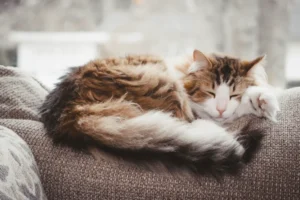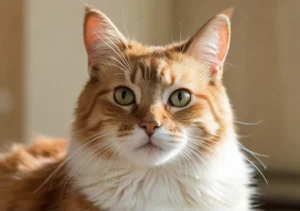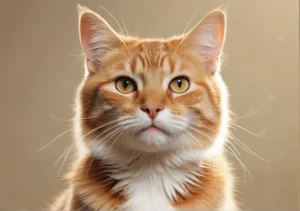Cats are known for their adorable high-pitched voices that can range from soft meows to loud yowls. Have you ever wondered why our feline friends have such unique vocalizations? Let’s explore the reasons behind why cats have high pitched voices.
Cats have high pitched voices due to their small vocal cords and unique anatomy. Their vocal cords are shorter and thinner compared to larger animals, resulting in higher frequency sounds. Let’s dive into the factors that contribute to cats’ high pitched voices.
Anatomical Reasons for High-Pitched Voices
Cats have naturally high-pitched voices due to their unique anatomical features. Their vocal cords are shorter and thinner compared to other animals, which creates a higher frequency sound when they meow. Additionally, the positioning of a cat’s larynx, or voice box, is higher in their throat, contributing to the higher pitch of their meows. These anatomical differences make cats’ voices distinct and easily recognizable among pet owners.
Communication Through Meows
Cats use their high-pitched voices to communicate a variety of messages to humans and other animals. When a cat lets out a short, urgent meow, it may be signaling hunger or a desire for attention. On the other hand, a long and drawn-out meow could indicate loneliness or discomfort. Cats also use different tones and pitches in their meows to convey specific emotions, such as excitement, frustration, or affection.
In addition to vocalizations, cats rely on body language and facial expressions to communicate effectively with their owners. For example, a happy and content cat may purr softly, while an anxious or agitated cat may hiss or growl. By paying attention to both their vocal cues and non-verbal signals, pet owners can better understand and meet their cats’ needs.
Extra Tip:
When deciphering a cat’s meows, consider the timing and context of their vocalizations. Sometimes, a high-pitched meow may simply be a playful greeting, while other times it could be a signal of distress or discomfort. By observing your cat’s behavior and listening to their meows attentively, you can strengthen the bond between you and your feline friend.
Evolutionary Adaptations
Cats have high-pitched voices as an evolutionary trait to communicate. In the wild, small prey animals often emit high-pitched sounds, so cats developed a similar vocal range to mimic their prey and communicate effectively with their young or humans. This adaptation allows them to convey a sense of urgency, need for attention, or express discomfort. Over time, selective breeding may have also influenced the pitch of cats’ voices, leading to variations depending on breed.
Medical Conditions Affecting Voice
Certain medical conditions can impact a cat’s voice and alter its pitch. Issues like laryngitis, upper respiratory infections, or growths in the throat can cause changes in vocalization. If your cat suddenly develops a high-pitched voice or experiences voice changes, it is crucial to consult with a veterinarian. Prompt medical attention can help identify and treat underlying conditions affecting your cat’s voice, ensuring their health and well-being.
Additional Insight:
Spotting changes in your cat’s voice, such as persistent high-pitched sounds or difficulty meowing, should be monitored closely. These changes can serve as early indicators of potential health issues, prompting timely veterinary intervention to address underlying concerns.
Remember, observing your cat’s vocalizations and seeking veterinary guidance are essential to maintaining their overall health and happiness. Keep an eye on any changes in your cat’s voice and prioritize their well-being by addressing any concerning shifts promptly. Maintaining open communication channels with your veterinarian is key in ensuring your feline companion’s optimal health.
Vocalizations in Different Breeds
Cats, just like us humans, have their own unique ways of expressing themselves through their vocalizations. From the siamese with their loud, piercing cries to the persian with their soft, melodious meows, each breed has its distinct pitch and volume. These differences can be attributed to genetic influences, as certain breeds have been selectively bred over time for specific vocal traits. So, if you have a maine coon with a deep, rumbling purr or a siamese with a loud, chatty voice, remember that it’s all in their genes!
Environmental Factors
Apart from genetic influences, a cat’s environment and upbringing can also play a significant role in shaping the pitch of their voice. Cats that are socialized at a young age tend to develop a more varied vocal range, as they learn to communicate effectively with humans and other animals. Quiet households may result in quieter, more reserved cats, while busy, noisy environments could lead to cats with louder, more high-pitched voices. Therefore, the environment in which a cat grows up can greatly influence the development of their vocalizations.
Helpful Resource:
- To further understand the impact of environmental factors on a cat’s vocalizations, check out this article on socializing cats: Socializing Cats
Social Behavior and Vocalizations
Cats have high-pitched voices as a crucial part of their social behavior. They use these sounds to communicate with other cats and even with humans. When your feline friend meows at you, they might be seeking attention, food, or simply wanting to interact. Interestingly, cats have developed a wide range of vocalizations to express emotions and intentions, from purring when content to yowling when upset. So, next time your cat meows at you, pay attention to the pitch and tone as they might be trying to tell you something important.
Fun Facts About Feline Vocalizations
Did you know that some cats have a special type of meow reserved just for human interaction? This “solicitation purring” is a high-pitched sound specifically designed to get the attention of their human companions. Also, cats can vary their meows to mimic the crying of a human baby, which triggers a nurturing response in their owners. Furthermore, research shows that cats rarely use meows to communicate with each other, reserving these sounds mainly for interactions with humans. This unique aspect of feline vocalizations highlights the special bond between cats and their human counterparts.
As a unique insight, research suggests that feline vocalizations can vary based on the breed of the cat. Certain breeds, such as Siamese cats, are known for their loud and high-pitched voices, while others, like Persians, tend to have softer and more melodious meows. This diversity in vocalizations adds another layer of complexity to the fascinating world of cat communication.
Alex, a passionate animal lover, has experience in training and understanding animal behavior. As a proud pet parent to two dogs and three cats, he founded AnimalReport.net to share insights from animal experts and expand his knowledge of the animal kingdom.




